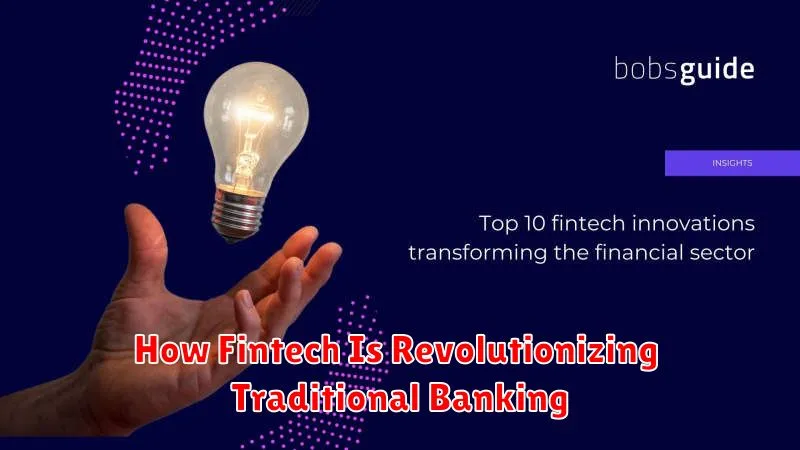The financial technology (fintech) sector is experiencing exponential growth, dramatically reshaping the landscape of traditional banking. Fintech innovations are challenging established norms, offering consumers and businesses a plethora of new financial products and services. This disruptive force impacts everything from how we make payments and manage investments to how we access loans and interact with financial institutions. The rise of digital banking, mobile payments, and blockchain technology exemplifies the transformative power of fintech, creating a more accessible, efficient, and competitive financial ecosystem. The implications for traditional banking are profound, demanding adaptation and innovation to remain relevant in this rapidly evolving market.
This article explores how fintech is revolutionizing traditional banking, examining the key drivers of change and the resulting challenges and opportunities. We will delve into the specific ways fintech companies are disrupting established financial models, focusing on areas such as online lending, peer-to-peer lending, robo-advisors, and the growing influence of cryptocurrencies. By understanding the core principles of this fintech revolution, we can better appreciate its potential to redefine the future of finance and the role of traditional banks in this new era.
Rise of Mobile Banking Apps
The proliferation of smartphones and mobile internet access has fueled the rapid growth of mobile banking applications. These apps offer customers unparalleled convenience, allowing them to manage their finances anytime, anywhere.
Key features such as balance checks, fund transfers, and bill payments are now readily available at users’ fingertips. This ease of access has significantly reduced reliance on traditional brick-and-mortar bank branches.
Furthermore, mobile banking apps often incorporate advanced security measures like biometric authentication and real-time transaction alerts, enhancing the overall safety and security of banking operations.
Enhanced Customer Experience
Fintech companies prioritize user-friendly interfaces and personalized services. This focus significantly enhances the customer experience compared to traditional banking.
Accessibility is a key differentiator. Fintech apps provide 24/7 access to financial services, eliminating the need for physical branch visits. This convenience is particularly appealing to younger generations and busy professionals.
Personalized financial management tools are another advantage. These tools empower customers to track spending, set budgets, and receive tailored financial advice, fostering greater financial literacy and control.
Cost Reduction and Efficiency

Fintech companies are inherently designed for efficiency. By leveraging technology like cloud computing and automation, they significantly reduce operational costs compared to traditional banks burdened with legacy infrastructure. This cost efficiency translates to lower fees and better interest rates for consumers.
Automated processes handle tasks like loan applications and customer service inquiries, eliminating the need for extensive human intervention. This not only speeds up processes but also minimizes human error, leading to improved accuracy and reduced processing times.
Real-Time Transactions
One of the most significant advancements fintech offers is the enablement of real-time transactions. Traditionally, bank transfers and payments could take days to clear, especially across borders or different financial institutions. Fintech companies leverage technologies like APIs and faster payment networks to facilitate instantaneous transfers.
This immediacy has profound implications for businesses and individuals. Businesses can manage cash flow more efficiently, reducing delays in receiving payments. Consumers benefit from immediate access to funds and the ability to make time-sensitive payments conveniently.
This shift towards real-time payments is pushing traditional banks to modernize their infrastructure and adopt similar technologies to remain competitive.
Innovative Payment Solutions
Fintech companies are driving a significant shift in how we make and receive payments. Real-time processing has become the norm, eliminating delays associated with traditional banking systems. This is largely facilitated by advancements in technologies like APIs and mobile platforms.
Mobile wallets and peer-to-peer (P2P) payment apps have gained immense popularity, offering convenient and often cost-effective alternatives to cash and checks. These solutions empower consumers with greater control over their finances and simplify everyday transactions.
Furthermore, the rise of contactless payments, including near-field communication (NFC) technology, enhances transaction speed and security. These innovations contribute to a more seamless and efficient payment experience for both consumers and businesses.
Data-Driven Personalization
Fintech companies leverage the power of data to deliver highly personalized financial services. By analyzing user transaction history, spending patterns, and even social media activity, these companies can tailor product offerings and advice to individual needs. This data-driven approach contrasts sharply with traditional banking’s “one-size-fits-all” model.
Personalized recommendations for investment products, budgeting tools, and loan options are becoming increasingly common. This level of personalization not only improves customer satisfaction but also promotes financial literacy and responsible financial management.
Open Banking Platforms
Open banking platforms are the technological backbone of this new financial landscape. These platforms facilitate the secure and standardized sharing of customer financial data through APIs (Application Programming Interfaces). This allows third-party developers to build innovative financial products and services tailored to individual needs.
Key features of these platforms include robust security measures, data encryption, and user consent mechanisms. They enable a seamless flow of information between banks and authorized third-party providers, fostering competition and driving innovation.
These platforms are a critical component in fostering financial inclusion by empowering consumers with greater control over their data and providing access to a broader range of financial services.
Blockchain and Cryptocurrencies
Blockchain technology, the foundation of most cryptocurrencies, presents a fundamental shift from traditional banking’s centralized model. It is a distributed ledger, recording transactions across multiple computers, enhancing transparency and security.
Cryptocurrencies, like Bitcoin and Ethereum, offer alternative payment methods, bypassing traditional intermediaries like banks. While still in its nascent stages, this technology possesses the potential to revolutionize cross-border payments, reduce transaction costs, and democratize access to financial services.
Key features of blockchain in finance include:
- Immutability: Once a transaction is recorded, it cannot be altered.
- Decentralization: No single entity controls the network.
- Enhanced Security: Cryptographic hashing protects against fraud.
Fintech Regulatory Challenges
The rapid growth of fintech presents significant regulatory challenges. Traditional regulatory frameworks often struggle to adapt to the speed of innovation, creating a gap between existing laws and the novel services offered by fintech companies.
Key areas of concern include data privacy, cybersecurity, and anti-money laundering (AML) compliance. The cross-border nature of many fintech operations adds further complexity, requiring international cooperation and harmonization of regulations.
Striking a balance between fostering innovation and ensuring consumer protection is crucial. Overly stringent regulations can stifle growth, while inadequate oversight can expose consumers to risks.
Future Outlook for Fintech

The future of fintech appears exceptionally bright, driven by continuous technological advancements and evolving consumer demands. Increased integration with artificial intelligence (AI) and machine learning (ML) will personalize financial services, automate processes, and enhance fraud detection.
Blockchain technology holds immense potential for transforming various aspects of finance, including payments, lending, and asset management. We can anticipate further growth in areas like decentralized finance (DeFi) and the exploration of central bank digital currencies (CBDCs).
Regulation will play a crucial role in shaping the future landscape, fostering innovation while mitigating risks. The convergence of fintech with traditional banking services is also expected to accelerate, creating a more dynamic and competitive financial ecosystem.

